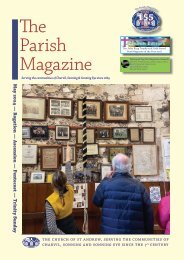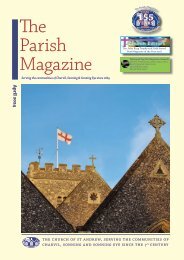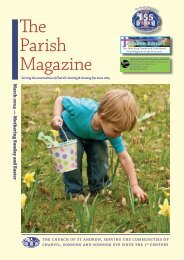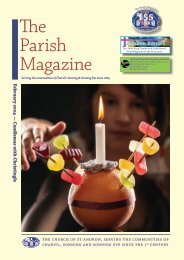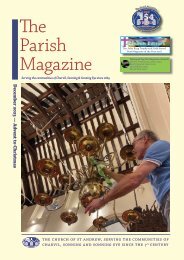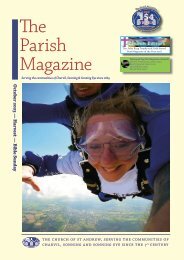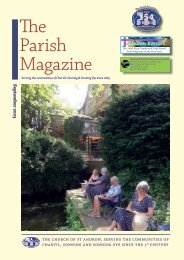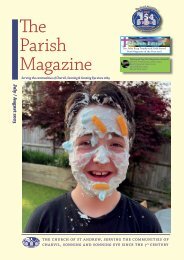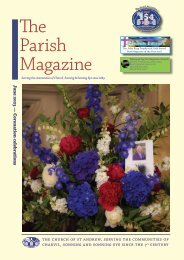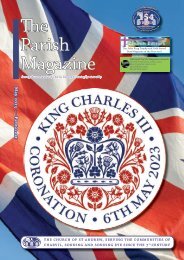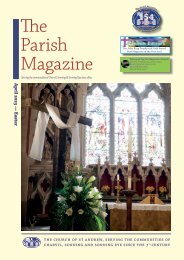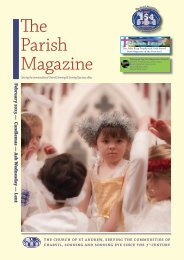The Parish Magazine January 2021
Create successful ePaper yourself
Turn your PDF publications into a flip-book with our unique Google optimized e-Paper software.
health
Dr Simon Ruffle writes about . . . plants
So, here we are in 2021. Predictions, resolutions and hopes for 2020 were roundly
beaten by a virus and its devastating effects. I sincerely hope that by the end of
this year we are all celebrating the end of 2021 as a year of recovery and hope for
all of our futures; and to give us some time to reflect on the past and not let the
sacrifices of many go to waste.
Like most years, it starts with 1 January.
History suggests that January was
added as a month in 450BC but it wasn’t
initially the first month of the year, that
was March. It seems to have changed
when the two consuls of Rome — while
it was a republic — started their year of
office on 1 January
January’s flower is the carnation. It
gets its name from the original, deep
red version reflecting the incarnation
of God into the flesh and blood of
Jesus. Carnations have long been used
in medicine and modern research
shows that there are highly potent
chemicals in carnations that may be
anti-cancer or antiviral.
The above trip into the rabbit hole
that is the internet leads me to writing
a few words on the use of botanicals in
medicine.
HEALING ARTS
Before analytical chemistry, trial,
error and vertical transmission of
knowledge was the way healers,
shaman, witch doctors and quacks
gained their knowledge. Like the
infinite monkey cage being able to
produce the works of Shakespeare,
they got it right — sometimes. Thus,
herbal treatments were better than
nothing, mostly.
Herbalism became more scientific
from the 10th Century onwards and
was given a massive boost by the
crusades bringing home teachings
from the east. Often, it was royalty and
the knight’s priests and monks that
were tasked with this work and this
was taken forward in monasteries.
Edith Pargeter (1913–1995) wrote
the wonderful Cadfael series under
the name 'Ellis Peters'. While fiction,
the work is based on a lot of facts and
the fable of a crusading knight who
turns to the healing arts and becomes
a monk on his return.
So what plants give us medicines?
Three of the most famous are poppies,
willow and foxglove; giving us opium,
‘aspirin’ and digitalis.
The best way to have a look at this
subject is to look at the chemicals
that the plants yield as the effect on
Poppy Victoria Tronina, unsplash.com
the body are similar despite different
plants producing the substances —
‘class effect.’
However, very slight changes to
the structure of the chemicals can also
have a very slight or enormous effect
on how the body reacts.
Alkaloids are found worldwide and
it is very likely that you have ingested
alkaloids today — if you are reading
this years ahead I bet I’m still correct!
Caffeine, nicotine, quinine and
turmeric are all alkaloids. Mostly weak
but have effects such as increasing gut
motility and mild euphoric effects.
Turmeric would need to be consumed
in huge quantities to produce an effect
and like most berberine (Berbaris)
derived chemicals are best used as dye.
Potent alkaloids are found in
poppies and deadly nightshade or the
inaptly named 'belladonna'.
Morphine, codeine, cocaine are
commonly used painkillers from
poppies and atropine hyoceine and
scopolamine are from belladonna and
used to dry recreations and stop some
muscle spasm, but will cause cardiac
Foxglove
Elisa Way, unsplash.com
The Parish Magazine - January 2021 35
Carnations Le Thuy Do, dreamstime.com
rhythm problems and arrest if used
incorrectly.
Opium has been used since 3,400BC.
The flower was known to the Sumerians
as 'hul gil', the joy flower.
Salicylates are produced from willow
and wintergreens. Aspirin was produced
in Germany in the late 19th and early
20th Century, however its use in fever
and pain is reckoned to be thousands of
years old. Aspirin is also vital in stopping
clots forming in the blood in people who
have had strokes or heart attacks.
UNTAPPED RESERVE
The most common glycoside is
from the foxglove. Foxglove extract
has been used for many centuries to
poison people. It changes the way the
electrical pathways work in the heart.
It is used in a common, but potentially
deadly, condition where the top part
of the heart contracts wildly out of
control. This causes that bottom part
of the heart to beat so fast that it
will cause a fall in blood pressure and
collapse. Digoxin stops the electrical
signal from passing from the top to the
bottom thus regulating the heart beat.
Other glycosides include senna,
which effects are well known but has
no effect on the heart.
The diversity of the plant world and
the vast difference in effects on the
body, shown by just a few examples,
suggests we have a large untapped
reserve of medicines in nature.
The fact that many common
herbs and spices have not been
thoroughly researched and we still
rely on anecdote as an antidote for
our ills means we need to protect the
environment and the wisdom of the
ancients too.




